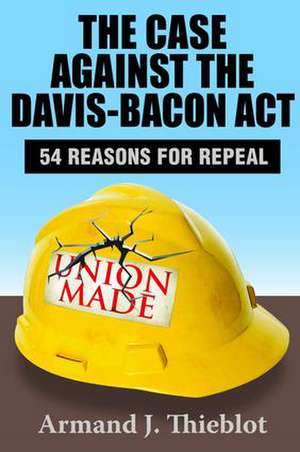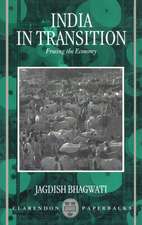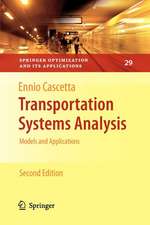The Case Against the Davis-Bacon Act: Fifty-Four Reasons for Repeal
Autor Armand J. Thiebloten Limba Engleză Hardback – 20 sep 2017
Thieblot deals with the history, purposes, and administrative concepts of prevailing wage laws, providing an overview of the act's administration. He covers the survey and determination process, and delves into how the act is administered. Thieblot summarizes its direct and indirect costs, evaluates counterclaims on the economic impact of Davis-Bacon, and considers compromises short of full repeal. Also included are seven appendices that provide full support for the conclusions summarized in the main text.
Thieblot documents a case against Davis-Bacon that is neither judgmental nor political, but he does question whether there is compelling public interest in maintaining a federal prevailing wage law. He puts forward a list of reasons why the Davis-Bacon Act should be repealed, making a convincing case that deserves action and not just simple consideration. This work should be read by all economists, lawmakers, and government officials.
| Toate formatele și edițiile | Preț | Express |
|---|---|---|
| Paperback (1) | 444.23 lei 6-8 săpt. | |
| Taylor & Francis – 15 feb 2013 | 444.23 lei 6-8 săpt. | |
| Hardback (1) | 992.90 lei 6-8 săpt. | |
| Taylor & Francis – 20 sep 2017 | 992.90 lei 6-8 săpt. |
Preț: 992.90 lei
Preț vechi: 1210.85 lei
-18% Nou
Puncte Express: 1489
Preț estimativ în valută:
190.16€ • 195.92$ • 159.29£
190.16€ • 195.92$ • 159.29£
Carte tipărită la comandă
Livrare economică 22 februarie-08 martie
Preluare comenzi: 021 569.72.76
Specificații
ISBN-13: 9781138534537
ISBN-10: 1138534536
Pagini: 292
Dimensiuni: 152 x 229 x 18 mm
Greutate: 0.45 kg
Ediția:1
Editura: Taylor & Francis
Colecția Routledge
Locul publicării:Oxford, United Kingdom
ISBN-10: 1138534536
Pagini: 292
Dimensiuni: 152 x 229 x 18 mm
Greutate: 0.45 kg
Ediția:1
Editura: Taylor & Francis
Colecția Routledge
Locul publicării:Oxford, United Kingdom
Cuprins
Foreword
Preface
Fifty-four Reasons for Repeal
Chapter I: Introduction
1. Davis-Bacon Act before 1935
2. Economic Claims Supporting Construction Wage Protection
3. Racial Animus, 1931
4. Probable Real Impetus for Davis-Bacon
5. The Central Concept Maintaining the Prevailing Wage
6. The Davis-Bacon Act after 1935
Chapter II: Overview of the Construction Industry and Its Labor Relations
1. Fungible Construction Output
2. Industrial Structure: The Union Pattern
3. Industrial Structure: The Nonunion Pattern
4. Craft Unions in the AFL
5. Semi-Skilled Workers and Helpers
6. Union and Nonunion Wage Rates, and the Union Wage Rate Differential
7. The Total Union Premium
8. Types of Construction Markets
Chapter III: Wage Determination Overview
1. Experience with Wage Determinations
2. Overview of Wage Determinations
3. Anatomy of Wage Survey Process
4. Safe Union Territory
5. Arbitrary Divisions among Work Regimes
6. Specialty Work and Worker Surveys
Chapter IV: The Helper Experiment
1. The Helper Rate Controversy
2. Summary of DOL's Handling of Helper and Helper-Like Rates
3.DOL's Questionable Implementation of Helper Usein Surveys During the Period of Non-Suspension
4. Summary of the Helper Controversy
Chapter V: Mechanics of Wage Surveys
1.Survey Mechanics
2. DOL's Manipulative Mechanics in Surveys, Illustrated by the 2002 Pittsburgh-area Residential Construction Survey
Chapter VI: Anatomy of a Wage Determination
1. Illustration from a Current Determination
2. Davis-Bacon Fosters Anomalies
3. Implicit Expansions to Unlisted Rates
Chapter VII: Costs, Counterclaims, Compromises, and Conclusions
1. Costs of Davis-Bacon
2. Counterclaims: The Benefits of Davis-Bacon
3. Compromise: Why Solutions Short of Repeal Won't Work
4. Conclusions
Appendix One: The Davis-Bacon Act
Appendix Two: The Construction Industry: Labor Organization and Manpower Use
Appendix Three: Proliferating Semi-Skilled Job Titles and the Helper Controversy
Appendix Four: Anomalies in Projects Used by DOL in Conducting Wage Survey 94-MD-022
Appendix Five: Mechanics of Wage Determination:The Pennsylvania Example
Appendix Six: A Few Anomalies from Current Pennsylvania Determinations
Appendix Seven: Excerpts from the Statements of Jeff Lester, Deputy Commissioner, Oklahoma Department of Labor
Selected Bibliography
Preface
Fifty-four Reasons for Repeal
Chapter I: Introduction
1. Davis-Bacon Act before 1935
2. Economic Claims Supporting Construction Wage Protection
3. Racial Animus, 1931
4. Probable Real Impetus for Davis-Bacon
5. The Central Concept Maintaining the Prevailing Wage
6. The Davis-Bacon Act after 1935
Chapter II: Overview of the Construction Industry and Its Labor Relations
1. Fungible Construction Output
2. Industrial Structure: The Union Pattern
3. Industrial Structure: The Nonunion Pattern
4. Craft Unions in the AFL
5. Semi-Skilled Workers and Helpers
6. Union and Nonunion Wage Rates, and the Union Wage Rate Differential
7. The Total Union Premium
8. Types of Construction Markets
Chapter III: Wage Determination Overview
1. Experience with Wage Determinations
2. Overview of Wage Determinations
3. Anatomy of Wage Survey Process
4. Safe Union Territory
5. Arbitrary Divisions among Work Regimes
6. Specialty Work and Worker Surveys
Chapter IV: The Helper Experiment
1. The Helper Rate Controversy
2. Summary of DOL's Handling of Helper and Helper-Like Rates
3.DOL's Questionable Implementation of Helper Usein Surveys During the Period of Non-Suspension
4. Summary of the Helper Controversy
Chapter V: Mechanics of Wage Surveys
1.Survey Mechanics
2. DOL's Manipulative Mechanics in Surveys, Illustrated by the 2002 Pittsburgh-area Residential Construction Survey
Chapter VI: Anatomy of a Wage Determination
1. Illustration from a Current Determination
2. Davis-Bacon Fosters Anomalies
3. Implicit Expansions to Unlisted Rates
Chapter VII: Costs, Counterclaims, Compromises, and Conclusions
1. Costs of Davis-Bacon
2. Counterclaims: The Benefits of Davis-Bacon
3. Compromise: Why Solutions Short of Repeal Won't Work
4. Conclusions
Appendix One: The Davis-Bacon Act
Appendix Two: The Construction Industry: Labor Organization and Manpower Use
Appendix Three: Proliferating Semi-Skilled Job Titles and the Helper Controversy
Appendix Four: Anomalies in Projects Used by DOL in Conducting Wage Survey 94-MD-022
Appendix Five: Mechanics of Wage Determination:The Pennsylvania Example
Appendix Six: A Few Anomalies from Current Pennsylvania Determinations
Appendix Seven: Excerpts from the Statements of Jeff Lester, Deputy Commissioner, Oklahoma Department of Labor
Selected Bibliography
Descriere
The Davis-Bacon Act is a United States federal law that established the requirement that prevailing wages must be paid on public works projects














